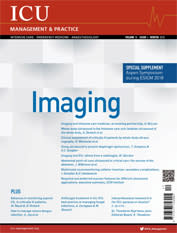Volume 18 - Issue 4, 2018
- ICU
- 24/01/2019
Change content default value
READ MORE
Our cover story this issue is Imaging. The radiology armamentarium is vast, with many imaging modalities available to aid diagnosis and monitoring of therapy in critically ill patients—both at the bedside (x-ray, ultrasound) and in the radiology department (MRI, CT and PET). Research is underway to image even deeper, such as the PROTEUS collaboration...
READ MOREThe secrets of the abdomen Overview of abdominal point-of-care ultrasound use in the ICU, potential diagnoses and findings common to the critical care patient population. The use of point-of-care ultrasound (POCUS) in critical care as a diagnostic and monitoring tool is rapidly expanding. While its role in cardiovascular and respiratory...
READ MORESecondary complications Reports on secondary complications arising from insertion of a multimodal monitoring sensor using a dual lumen introducer kit in patients with subarachnoid haemorrhage, head injury or intracranial haemorrhage. Maintenance of sufficient cerebral oxygen supply to meet metabolic demand is a key goal in managing...
READ MOREExecutive summary Minimum requirements, preferred features, and other advantageous features are identified for ultrasound systems for common exam types. Ultrasound is used for a wide variety of clinical applications, each requiring a somewhat different set of sonographic capabilities. A scanner's array of available features is a key...
READ MOREAsking why the patient needs to be sedated is as important as the choice of drug for sedation. Why use sedation? Intensivists should ask why they use sedation every time they order it. Sedation is used to reduce the burden and stress of critical illness. Sedative agents mixed with analgesic agents reduce pain and keep the patient calm,...
READ MOREFrom massive sedation in the past, through current sedation practice relying on cooperation between patients and care providers, the future may further improve sedation in the ICU. The concepts for good sedation include defining the range of sedation, the need for agents with rapid response that can be easily and rapidly varied in restless...
READ MOREPanacea or illusion? Reflections on key research insights into interprofessional teamwork in the ICU with a critical yet optimistic view for its future. Over the years, interprofessional teamwork in the intensive care unit (ICU) has been viewed as a panacea to most ills and indeed described as a core value of critical care practice...
READ MOREICU Management & Practice is delighted to announce that Dr. Theodoros Kyprianou, MD, PhD, EDIC, has joined the Editorial Board. Dr. Kyprianou will be Section Editor for the new Informatics & Technology section in the journal, starting in 2019. Dr. Kyprianou is a consultant physician in Respiratory & Intensive Care Medicine, practising in Cyprus...
READ MORE
4th Dubai International Conference on Infectious Diseases and Vaccination (DICID)
READ MORE